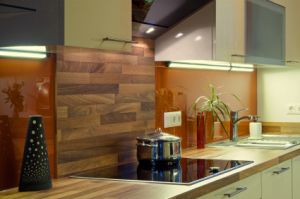Kitchen Lighting
 If you are lighting your kitchen, you need to consider how the background lights will work with the lights you have set for food prep and other tasks, as well as the lights that are intended to bring attention to certain features in your kitchen.
If you are lighting your kitchen, you need to consider how the background lights will work with the lights you have set for food prep and other tasks, as well as the lights that are intended to bring attention to certain features in your kitchen.
Here are some tips for harmoniously lighting your kitchen.
Ambient Lights
Ambient lights make up most of the lighting in a kitchen. The ultimate purpose of ambient lighting is to make the navigation of a room second nature, and, in fact, it is probably safe to say that most rooms in homes have ambient lighting. Ambient lights can take the form of a simple on-off switch, and can also be set to a dimmer so that mood lighting becomes a feature of the room. Diffused white light is, for most people, the best choice for ambient light in the kitchen.
You cannot have a kitchen without ambient lights, whether you choose to use recessed lighting cans, hanging chandeliers, or other forms of general lighting.
Task Lights
Task lights are often a prominent feature in kitchens. Where ambient lights are important for making the entire room navigable, task lights zone in on a particular area. Because ambient lights often cast shadows that make it difficult to see what you are doing on a countertop or at the stove, task lights are an important addition to the overall lighting of the kitchen.
Task lights are the types of light that are usually placed beneath wall cabinets so that a user can focus on, quite literally, the task at hand. These lights illuminate a countertop to prepare meals. Fluorescent lights are a safe and often used option for task lighting, but recessed lights are also a functional choice. Pendant lights can be used to provide both an aesthetic statement and a practical task light for counters.
Accent Lights
When it comes to harmonizing the lighting in your kitchen, accent lighting can add a dramatic flair to finalize the overall look of the space. Accent lights for your kitchen can also be placed underneath cabinets for dual form and function. Think of accent lights as something like a museum light, which can bring attention to a unique feature of the space or even flooring with an interesting or unique design. Where kitchens often have a lot of hard edges (consider, for example, rectangular refrigerators, kitchen cabinets, or granite countertops), accent lighting can serve as a way to soften the edges.
Whatever the lighting approach, by incorporating a combination of ambient lighting, task lighting, and accent lighting, you can create a harmonious and elegant or even a more modern way to light your kitchen.